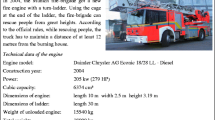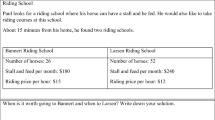Abstract
An effective way to improve students’ mathematical knowledge is to have them construct multiple solutions for real-world problems. Prior knowledge is a relevant prerequisite for learning outcomes, and the experience of competence is a basic need that has to be fulfilled to improve achievement. In the current experimental study (N = 307), we investigated how the construction of multiple solutions for real-world problems by applying multiple (two) mathematical procedures affected students’ procedural and conceptual knowledge and their experience of competence. Path analyses showed that constructing multiple solutions for real-world problems increased students’ feelings of competence and affected their procedural and conceptual knowledge indirectly through the experience of competence. Moreover, students’ prior knowledge affected their knowledge at posttest directly as well as indirectly via their experience of competence.






Similar content being viewed by others
References
Achmetli, K., Schukajlow, S., & Krug, A. (2014). Effects of prompting students to use multiple solution methods while solving real-world problems on students' self-regulation. In C. Nicol, S. Oesterle, P. Liljedahl, & D. Allan (Eds.), Proceedings of the Joint Meeting of PME 38 and PME-NA 36 (Vol. 2, pp. 1-8). Vancouver, Canada: PME.
Bandura, A. (2003). Self-efficacy: The exercise of control (6. printing. ed.). New York, NY: Freeman, Self-Efficacy.
Becker, J. P., & Shimada, S. (1997). The open-ended approach: A new proposal for teaching mathematics. Reston, VA: National Council of Teachers of Mathematics.
Blum, W., & Leiss, D. (2007). How do students and teachers deal with mathematical modelling problems? The example sugarloaf and the DISUM project. In C. Haines, P. L. Galbraith, W. Blum, & S. Khan (Eds.), Mathematical modelling (ICTMA 12): Education, engineering and economics (pp. 222–231). Chichester, England: Horwood.
Boekaerts, M., & Corno, L. (2005). Self-regulation in the classroom: A perspective on assessment and intervention. Applied Psychology, 54(2), 199–231.
Bond, T. G., & Fox, C. M. (2001). Applying the Rasch model: Fundamental measurement in the human sciences. Mahwah, NJ: Lawrence Erlbaum.
Canobi, K. H. (2009). Concept–procedure interactions in children’s addition and subtraction. Journal of Experimental Child Psychology, 102(2), 131–149.
Collins, A., Brown, J. S., & Newman, S. E. (1989). Cognitive apprenticeship: Teaching the crafts of reading, writing, and mathematics. In L. B. Resnick (Ed.), Knowing, learning and instruction: Essays in honor of Robert Glaser (pp. 453–492). Hillsdale, NJ: Erlbaum.
Deci, E. L. (1998). The relation of interest to motivation and human needs: The self-determination theory viewpoint. In L. Hoffmann, A. Krapp, K. A. Renninger, & J. Baumert (Eds.), Interest and Learning Proceedings of the Seeon-conference on interest and gender (Vol. 1998, pp. 146–162). Kiel, Germany: IPN.
Deci, E. L., & Ryan, A. M. (2000). The “what“ and “why“ of goal pursuits: Human needs and the selfdetermination of behavior. Psychological Inquiry, 11(4), 227–268.
Deci, E. L., & Ryan, R. M. (1991). A motivational approach to self: Integration in personality. In R. A. Dienstbier (Ed.), Perspectives on motivation (Vol. 38, pp. 237–288). Lincoln, NE: University of Nebraska Press.
Fisher, W. P. (1992). Reliability statistics. Rasch Measurement Transactions, 6(3), 238.
Goldin, G. A. (2014). Perspectives on emotion in mathematical engagement, learning, and problem solving. In R. Pekrun & L. Linnenbrink-Garcia (Eds.), International handbook of emotions in education (pp. 391–414). New York, NY: Routledge.
Hänze, M., & Berger, R. (2007). Cooperative learning, motivational effects, and student characteristics: An experimental study comparing cooperative learning and direct instruction in 12th grade physics classes. Learning and Instruction, 17(1), 29–41.
Hattie, J. (2009). Visible learning : A synthesis of meta-analyses relating to achievement. London, England: Routledge.
Hattie, J., Biggs, J. B., & Purdie, N. (1996). Effects of learning skills interventions on student learning: A meta-analysis. Review of Educational Research, 66, 99–136.
Heinze, A., Reiss, K., & Rudolph, F. (2005). Mathematics achievement and interest in mathematics from a differential perspective. ZDM Mathematics Education, 37(3), 212–220.
Kline, R. B. (2005). Principles and practice of structural equation modeling. New York, NY: Guilford Press.
Krapp, A. (2005). Basic needs and the development of interest and intrinsic motivational orientations. Learning and Instruction, 15, 381–395.
Leikin, R., & Levav-Waynberg, A. (2007). Exploring mathematics teacher knowledge to explain the gap between theory-based recommendations and school practice in the use of connecting tasks. Educational Studies in Mathematics, 66(3), 349–371.
Levav-Waynberg, A., & Leikin, R. (2012). The role of multiple solution tasks in developing knowledge and creativity in geometry. Journal of Mathematical Behavior, 31, 73–90.
Miserandino, M. (1996). Children who do well in school: Individual differences in perceived competence and autonomy in above-average children. Journal of Educational Psychology, 88, 203–214.
Muthén, B. O., & Satorra, A. (1995). Complex sample data in structural equation modeling. Sociological Methodology, 25, 267–316.
Muthén, L. K., & Muthén, B. O. (1998–2012). Mplus user’s guide (5th ed.). Los Angeles, CA: Muthe’n & Muthe’n.
National Council of Teachers of Mathematics. (2000). Principles and standards for school mathematics. Reston, VA: Author.
Neubrand, M. (2006). Multiple Lösungswege für Aufgaben: Bedeutung für Fach, Lernen, Unterricht und Leistungserfassung [Multiple procedures for problems: Importance for content, learning, teaching and measurement of performance]. In W. Blum, C. Drüke-Noe, R. Hartung, & O. Köller (Eds.), Bildungsstandards Mathematik: Konkret. Sekundarstufe I: Aufgabenbeispiele, Unterrichtsanregungen, Fortbildungsideen [Standards for school mathematics on the low-secondary level: Tasks, ideas for teaching and teacher training] (pp. 162–177). Berlin, Germany: Cornelsen.
Niss, M., Blum, W., & Galbraith, P. L. (2007). Introduction. In W. Blum, P. L. Galbraith, H.-W. Henn, & M. Niss (Eds.), Modelling and applications in mathematics education: The 14th ICMI study (pp. 1–32). New York, NY: Springer.
Pekrun, R., Goetz, T., Frenzel, A. C., Barchfeld, P., & Perry, R. P. (2011). Measuring emotions in students’ learning and performance: The achievement emotions questionnaire (AEQ). Contemporary Educational Psychology, 36, 36–48.
Pietsch, J., Walker, R., & Chapman, E. (2003). The relationship among self-concept, self-efficacy, and performance in mathematics during secondary school. Journal of Educational Psychology, 95(3), 589–603.
Rittle-Johnson, B., & Schneider, M. (2014). Developing conceptual and procedural knowledge of mathematics. In C. R. Kadosh & A. Dowker (Eds.), Oxford handbook of numerical cognition (pp. 1102–1118). Oxford, England: Oxford University Press.
Rittle-Johnson, B., Schneider, M., & Star, J. R. (2015). Not a one-way street: Bidirectional relations between procedural and conceptual knowledge of mathematics. Educational Psychology Review, 27(4), 587–597.
Rittle-Johnson, B., Siegler, R. S., & Alibali, M. W. (2001). Developing conceptual understanding and procedural skill in mathematics: An iterative process. Journal of Educational Psychology, 93(2), 346–362.
Rittle-Johnson, B., & Star, J. R. (2007). Does comparing solution methods facilitate conceptual and procedural knowledge? An experimental study on learning to solve equations. Journal of Educational Psychology, 99(3), 561–574.
Rittle-Johnson, B., & Star, J. R. (2009). Compared with what? The effects of different comparisons on conceptual knowledge and procedural flexibility for equation solving. Journal of Educational Psychology, 101(3), 529–544.
Rittle-Johnson, B., Star, J. R., & Durkin, K. (2009). The importance of prior knowledge when comparing examples: Influences on conceptual and procedural knowledge of equation solving. Journal of Educational Psychology, 101(4), 836–852.
Rupp, A. A., Templin, J., & Henson, R. A. (2010). Diagnostic measurement: Theory, methods, and applications (Vol. 1). New York, NY: The Guilford Press.
Ryan, R. M. (1995). Psychological needs and the facilitation of integrative processes. Journal of Personality, 63(3), 397–427.
Ryan, R. M., & Deci, E. L. (2000). Self-determination theory and the facilitation of intrinsic motivation, social development, and well-being. American Psychologist, 55, 68–78.
Schukajlow, S., Leiss, D., Pekrun, R., Blum, W., Müller, M., & Messner, R. (2012). Teaching methods for modelling problems and students’ task-specific enjoyment, value, interest and self-efficacy expectations. Educational Studies in Mathematics, 79(2), 215-237.
Schukajlow, S., & Krug, A. (2014). Do multiple solutions matter? Prompting multiple solutions, interest, competence, and autonomy. Journal for Research in Mathematics Education, 45(4), 497-533.
Schukajlow, S., Krug, A., & Rakoczy, K. (2015). Effects of prompting multiple solutions for modelling problems on students’ performance. Educational Studies in Mathematics, 89(3), 393-417.
Schukajlow, S., & Rakoczy, K. (2016). The power of emotions: Can enjoyment and boredom explain the impact of individual preconditions and teaching methods on interest and performance in mathematics? Learning and Instruction, 44, 117-127.
Silver, E. A., Ghousseini, H., Gosen, D., Charalambous, C. Y., & Font Strawhun, B. T. (2005). Moving from rhetoric to praxis: Issues faced by teachers in having students consider multiple solutions for problems in the mathematics classroom. Mathematical Behavior, 24(3–4), 287–301.
Spiro, R. J., Coulson, R. L., Feltovich, P. J., & Anderson, D. K. (1988). Cognitiv flexibility theory: Advanced knowledge aquisition in ill-structured domains. The tenth annual conference of the cognitive science society (pp. 375–383). Hillsdale, NJ: Lawrence Erlbaum.
Star, J. R. (2007). Foregrounding procedural knowledge. Journal for Research in Mathematics Education, 38, 132–135.
Star, J. R., & Rittle-Johnson, B. (2008). Flexibility in problem solving: The case of equation solving. Learning and Instruction, 18, 565–579.
Warm, T. A. (1989). Weighted likelihood estimation of ability in item response theory. Psychometrika, 54, 427–450.
Wigfield, A., Battle, A., Keller, L. B., & Eccles, J. S. (2002). Sex differences in motivation, self-concept, career aspiration, and career choice: Implications for cognitive development. In R. De Lisi & a. McGillicuddy-De Lisi (Eds.), The development of sex differences in cognition (pp. 93–124). Westport, CT: Ablex Publishing.
Wu, M. L., Adams, R. J., & Wilson, M. R. (1998). ACER conquest. Melbourne, Australia: The Australian Council for Educational Research.
Author information
Authors and Affiliations
Corresponding author
Additional information
The data were collected in the framework of MultiMa-Project (Multiple solutions for Mathematics teaching oriented towards students’ self-regulation). This project was financially supported by a grant from the Deutsche Forschungsgemeinschaft (DFG) allocated to the second author (SCHU 2629/1-1/2).
Electronic Supplementary Material
ESM 1
(DOCX 138 kb)
Rights and permissions
About this article
Cite this article
Achmetli, K., Schukajlow, S. & Rakoczy, K. Multiple Solutions for Real-World Problems, Experience of Competence and Students’ Procedural and Conceptual Knowledge. Int J of Sci and Math Educ 17, 1605–1625 (2019). https://doi.org/10.1007/s10763-018-9936-5
Received:
Accepted:
Published:
Issue Date:
DOI: https://doi.org/10.1007/s10763-018-9936-5




